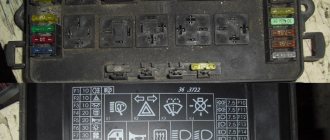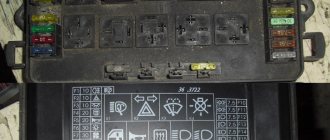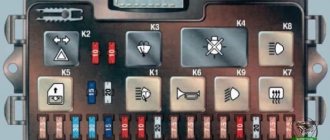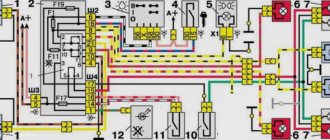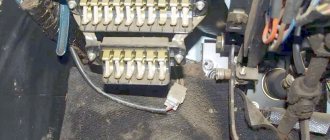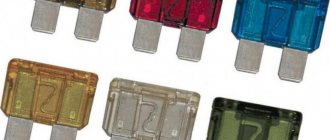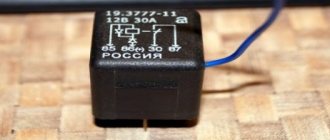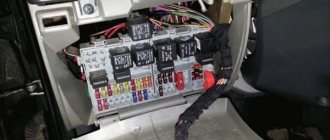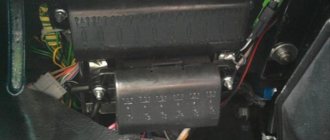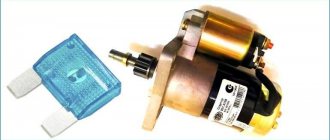Where is the VAZ fuse mounting block located: 2104, 2105 (carburetor, injector)
The mounting block is located in the engine compartment on the right side and is attached to the front panel. The mounting block is closed on top with a lid on which symbols for the purpose of the relay, fuse numbers and the circuits they protect are printed. Most of the vehicle's electrical circuits are protected by fuses installed in the mounting block.
| Fuse number | Current strength, A | Protected Circuits |
| F1 | 10 | Tail lights (reversing lights). Heater motor Warning lamp and rear window heating relay (winding) |
| F2 | 10 | Electric motors for the windshield wiper and washer pump. Windshield wiper relay |
| F3 | 10 | Spare |
| F4 | 10 | Spare |
| F5 | 20 | Rear window heating element and heating relay (contacts) |
| F6 | 10 | Cigarette lighter. Portable lamp socket |
| F7 | 20 | Sound signals and relay for turning on sound signals. Engine cooling fan motor and motor switch relay (contacts) |
| F8 | 10 | Direction indicators in hazard warning mode. Switch and relay-interrupter for direction indicators and hazard warning lights in emergency mode |
| F9 | 7.5 | Generator voltage regulator (on vehicles with G-222 generator) |
| F10 | 10 | Turn indicators in turn signal mode and corresponding indicator lamp. Turn signal interrupter relay. Turn signal indicator Tachometer Fuel level indicator. Coolant temperature gauge. Voltmeter. Fan motor activation relay (winding). Battery charge indicator lamp. Indicator lamps for fuel reserve and parking brake activation. Warning lamps for emergency drop in oil pressure and insufficient brake fluid level. Indicator lamp for turning on the parking brake. Indicator lamp for covering the carburetor air damper (for a carburetor engine). Electric fan thermal switch. Carburetor pneumatic valve control system Generator excitation winding (generator 37.3701) |
| F11 | 10 | Rear lights (brake lamps). Body interior light |
| F12 | 10 | Right headlight (high beam). Winding of the relay for turning on the headlight cleaners (with the high beams on) |
| F13 | 10 | Left headlight (high beam). Indicator lamp for high beam headlights |
| F14 | 10 | Left headlight (side light). Right rear light (side light). License plate lights. Engine compartment lamp Indicator lamp for turning on side lights |
| F15 | 10 | Right headlight (side light). Left rear light (side light). Cigarette lighter lamp. Instrument lighting lamp. Glove compartment lamp |
| F16 | 10 | Right headlight (low beam). Winding of the relay for turning on the headlight cleaners (with the low beam on) |
| F17 | 10 | Left headlight (low beam) |
Mounting block connection diagram:
P1 — relay for turning on the heated rear window; P2 - relay for turning on headlight cleaners and washers; PЗ - relay for turning on sound signals; P4 - relay for switching on the electric motor of the engine cooling system fan; P5 - headlight high beam relay; P6 — headlight low beam relay; A - the order of conditional numbering of plugs in the mounting block blocks. The outer number with the letter “Ш” in the plug designation is the block number, and the inner number is the conventional number of the plug. The plugs of the blocks without color marking are conventionally shown in brown
Location of relays and fuses in the mounting block : 1 - relay for turning on the heated rear window; 2 — place for installing a relay for turning on headlight cleaners and washers (the relay is installed on some manufactured cars); 3 — mounting jumper in place of the relay for turning on sound signals (in a variant, a relay is installed); 4 — mounting jumper in place of the relay for turning on the electric motor of the cooling system fan (in a variant version, a relay is installed); 5 — relay for turning on the high beam headlights; 6 — relay for turning on low beam headlights; F1-F17 - fuses (circuits protected by pin-type fuses are indicated in the table above).
Electrical equipment that consumes high current during operation is connected through relays that protect switch contacts from overload. To replace pin fuses and relays, special plastic tweezers are provided in the mounting block. Fuses of different ratings are painted in different colors; In addition, the fuse is marked with a numerical value of the current for which it is designed (rated value). The color of the fuse body and its correspondence to the rating 20A - Yellow 15A - Blue 10A - Red 7.5A - Brown
What is the difference between the mounting blocks on the VAZ-2104, 2105 and 2107?
Unfortunately, I don’t have complete information, so we’ll look at the main differences. Finger fuse block that everyone replaces
All blocks for classics differ in the connection of fuse 9, the connection of relay winding P4, as well as the presence/absence of contacts on relays P3 and (or) P4. And let's begin:
Changes with fuse 9
On cars with a G-222 generator (used until 1987), fuse 9 was connected to the ignition and, through Ш11/3, fed the generator relay-regulator. The voltage was controlled by a voltmeter, and the charge lamp has not been connected since 1985. And on the instrument panel 2105 it could still be connected in different ways (to plus or minus).
When they started installing generators from the VAZ-2108 (37.3701), there was no need to supply power. The generator was excited through a charge lamp, and it was powerful (the generator would not have been excited through a small one). Fuse 9 was connected to the rear fog lights, the circuit Ш3/3 - Ш13/1 from the fog lamp button to the lights broke.
Which fuse is responsible for the cigarette lighter of the VAZ 2104?
Fuse decoding table for VAZ / Lada 2104/2105/2107 (v. 2)
| Number | Rated current, A | Purpose of the fuse |
| 6 | 10 | Cigarette Lighter Clock |
| 7 | 20 | Sound signals Radiator cooling fan |
| 8 | 10 | Hazard warning lights Direction indicators (in hazard warning mode) |
| 9 | 7,5 | Rear fog lights |
Fuse box in the cabin of the "four"
Most modifications of the VAZ 2104 are equipped with only one power supply unit - in the engine compartment. However, the injection versions of this car have an additional unit, which is located in the cabin under the glove box. This block is a bar with several elements located on it:
- main relay;
- fuel pump relay;
- fan relay.
Fuse links provide protection:
- main relay;
- electric fuel pump;
- electronic engine control unit.
How to remove the fuse box
The need to remove the power supply may arise when replacing a relay or protective elements of the motor control system. To do this, the bar itself on which the parts are held is dismantled. The procedure goes as follows:
- We de-energize the on-board network by removing the negative terminal of the battery.
- We unscrew the fasteners of the bracket to the body.
The connection of elements in the additional block of the VAZ 2104 is made using connectors and in case of problems, only the parts are changed.
To increase the reliability of the electrical equipment of the VAZ Four, it is advisable to install a new model of the fuse box. If this is not possible, then periodic repairs of the old unit can be performed with a minimum set of tools and without special knowledge. It will be enough to read the step-by-step instructions and follow them during the repair process.
Which fuse is responsible for reverse gear on a VAZ 2105?
Table: which fuse is responsible for what
| Fuse | Rated current, A | What protects |
| F1 | 10 | reverse lighting, electric heater, relay coil and rear window heating indicator |
| F2 | 10 | windshield washer motor, headlight washer motor and relay, windshield wiper relay |
| F3 | 10 | spare |
| F4 | 10 | spare |
THIS IS INTERESTING: What engine does the Nissan Almera have?
Common faults and solutions
The reasons why wipers do not work on cars, regardless of whether it is a UAZ or a S7, are basically the same. Below are the malfunctions and methods for eliminating them.
| Malfunction | Remedy |
| The wipers do not work in both modes. | In this case, you should check the fuses. If they are burnt out, they need to be replaced with new ones. If only the contacts have oxidized, you need to pull out the fuses several times and put them in place. It may be necessary to replace the VAZ wiper trapezoid. |
| Brushes do not work only in intermittent mode. | In this case, you first need to check the power supply. If there is voltage, then the cause of the breakdown is in the relay. |
| The wiper switch is faulty | Change three lever switch |
| The wipers work, but when turned off they remain in an arbitrary position. The reason may be a breakdown of the gearbox, since it contains a limit switch. | It is necessary to clean the contacts or bend the switch plate. If necessary, the gearbox should be replaced. |
| The electric motor does not work. | In this case, you need to dismantle the electric motor and check the condition of the windings and brushes. |
| The brushes do not move when the gearbox is running. | The gear teeth are broken and need to be replaced. The crank may be loosely secured to the gear; you need to tighten the fastening nut. |
Yellow markings on the road - what they mean according to traffic rules
An increasing number of domestic drivers have begun to pay attention to the fact that unusual yellow markings have now appeared on the roads. And a logical question immediately arises about what it means according to traffic rules and what it is needed for. The article will talk about what yellow markings on the road mean and how they differ from orange ones.
CONTENT
What are the marking colors?
Several years ago, GOST came into effect, affecting the rules and procedure for applying markings in the Russian Federation. Some colors were added accordingly.
The white marking remained the main one.
Orange was approved as the color that designated temporary markings applied while road work was being carried out.
In addition, yellow and red have been added to these marking colors. Among other things, there are markings in blue, black and green.
True, the last three colors have not yet been included in the traffic rules, so they are unlikely to be seen on the road.
You need to know that yellow and orange markings are different things.
Such a variety of colors is necessary in order to increase the level of road safety. All the colors that were listed earlier are of the horizontal and vertical type.
Yellow markings on the road - why they are needed.
Yellow markings are used to prohibit certain actions. Its functions are the same as those of white markings were before. The only difference is that yellow markings are more visible, and this can increase the degree of overall road safety, because yellow markings are easier to see in bad weather or if snow has fallen.
Yellow markings can be of different types and used in different places. According to each of them, different points of the rules will apply.
Yellow markings - to improve visibility, instead of white.
Recently, GOST introduced such a clause that the markings, which previously were always white - permanent markings, can now be drawn in yellow. They say that it will be better visible in winter. Its meaning will be the same as that of the white marking. True, it has not yet been introduced into the traffic rules, and therefore we do not often see it on the road.
What kind of markup is this? Let's get to know her.
Double solid yellow markings
Double solid yellow markings are used to separate traffic flows. It is forbidden to cross!
Single solid yellow marking
This marking will be used instead of white marking 1.1 to separate traffic flows in opposite directions, and may mark the boundaries of traffic lanes in dangerous places on the roads; mark the boundaries of the roadway where entry is prohibited; marks the boundaries of vehicle parking spaces. It is forbidden to cross!
Single broken yellow marking
Marking 1.5 will be used to separate traffic flows in opposite directions on roads that have two lanes in both directions, to mark the boundaries of traffic lanes when there are two or more of them in one direction.
Marking 1.6 – yellow
The line where the strokes are longer than the spaces between them is called the approach line, will tell the driver that the intermittent line will soon end and there will be a solid marking line.
Double broken yellow markings.
A double broken yellow line is used in the same place as the white line to indicate the boundaries of reversible lanes.
Marking 1. 11 – yellow
- separates traffic flows of opposite or similar directions on sections of roads where changing lanes is allowed only from one lane;
- indicates places where it is necessary to allow movement only from the side of the broken line (at places of turn, entry and exit from the adjacent territory);
Yellow markings on the road - to prohibit stopping and parking
Yellow solid markings will be used to prohibit stopping on any section of the road.
This markup is numbered 1.4
This marking looks like an ordinary solid line and will be applied either to the curb stone or instead of markings separating the roadway from the side of the road.
This marking will prohibit STOPPING of vehicles.
“Stop” is a deliberate stop in the movement of a vehicle for up to 5 minutes, as well as for longer if this is necessary for boarding or disembarking passengers or loading or unloading the vehicle.
A yellow intermittent sign will be used to prohibit parking on a section of road.
In the picture above, it will be prohibited to park your vehicle in the PARKING PARK .
“Parking” is the intentional cessation of movement of a vehicle for a period of more than 5 minutes for reasons not related to the embarkation or disembarkation of passengers or the loading or unloading of the vehicle.
White and yellow pedestrian markings
To improve the visibility of a pedestrian crossing, the zebra can be painted white and yellow.
A pedestrian crossing can be marked without yellow stripes, but its purpose will not change - it is intended for pedestrians to cross the roadway.
The marking is a yellow zigzag on the road.
In addition, yellow markings can be applied in a zigzag or at an angle. This way the places where public transport stops are indicated. Ordinary drivers are not allowed to stop at these markings (unless they are loading or unloading a passenger, and even then without causing interference)
Waffle markings at an intersection
This is what they call markings that look like a waffle)
This markup will be used for clarity. If there are markings, the driver can clearly see the boundaries of the zone within which he cannot stop. This allows you to assess even before entering the intersection whether it will be possible to leave it without violating the requirements of the rules if a traffic jam has formed ahead along the route, which will force the driver to stop, creating an obstacle to the movement of vehicles.
It was specially invented so that there would be no disputes when recording an offense. I stopped at the markings, if I violated the camera, everything will be clearly recorded.
With this, we have discussed all the types of yellow markings that exist today. Not all of them can be found on the road, since some types are still in GOST, but they are not in the text of the traffic rules.
Troubleshooting
- The wipers do not turn on. In this situation, most likely the reason is that the fuse has blown, which protects the circuits from excessive loads and short circuits. Therefore, first you need to check it. This is done using a special tester. If you don’t want to check, it’s time to immediately replace it with a new one. The fuse contacts could also have oxidized; it will be enough to clean them and then install them back.
- The wipers act up in intermittent mode. Here the breakdown lies precisely in the relay. The verification process is quite simple, you need to apply power to the relay block. To do this you need:
- remove the relay;
- then use the switch (near the steering wheel) to turn on the wipers;
- then the tester checks whether there is voltage in the terminal.
The switch will have to be replaced if there is no power. The control circuit could also have broken; this option should also be excluded. The relay cannot be repaired, so even if there is power, but it does not work, it needs to be changed.
- If the reason is in the electric motor of the cleaner. When there is voltage at the contacts of the electric motor, but the motor itself is “silent,” it means that the problem lies in a malfunction of the device itself. The windings could have failed or the brushes may have worn out. The former break if the motor is overloaded, while the latter simply wear out over time. In this case, repairs yourself are impossible, and you should contact a car repair shop.
- The wipers freeze. Quite often in domestic cars (and the VAZ 2107 is no exception) you may encounter the fact that when they are turned off, the wipers do not occupy the required initial position, but remain where they were at the time they were turned off. The problem in this case lies precisely in the drive gearbox. It has a limit switch and is actuated by a cam. And the job of the cam, in turn, is precisely to control where the brushes will be after the power stops being supplied to the switch lever. A malfunction in this option in most cases occurs when the driver turns on the wipers that are frozen to the glass. As a result, the gearbox breaks down and needs to be replaced.
Good day to all! People help! When the ignition is turned on, the front wipers constantly work. The wiper intensity switch works, but cannot be turned off. I pulled out the fuse, I'm driving without wipers and without windshield washer for now because everything is connected to one fuse. Hellp, who has encountered such a glitch! It’s already spring outside, everything is running and melting, there’s enough clean glass for 100m, without wipers and washers it’s a complete mess. As I understand it, there is a short somewhere, most likely water got in somewhere. I can’t catch up, maybe someone had something similar. Tell.
Take the steering column switch apart and clean it, it should help
Put the toggle switch on and it’s like on an airplane: click and the brushes work
